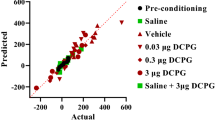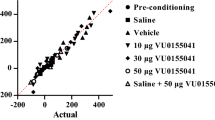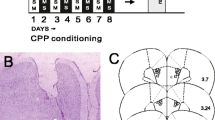Abstract
Rationale
Recent experiments from this laboratory demonstrated synergistic effects of AMPA/kainate receptor blockade and D2/3 dopamine (DA) receptor stimulation on brain stimulation reward and locomotor activity.
Objectives
Using place conditioning, this study explored further the interaction between DA and glutamate (Glu) using the N-methyl-d-aspartate (NMDA) receptor antagonist MK-801, the AMPA/kainate receptor antagonist NBQX, and the D2/3 DA receptor agonist 7-OH-DPAT.
Methods
Effects of these compounds, alone and combined, were measured in male Sprague–Dawley rats using an unbiased two-compartment place conditioning procedure.
Results
7-OH-DPAT (0.03–5.0 mg kg−1, s.c.) administered immediately prior to conditioning was ineffective; when administered 15 min prior to conditioning, only the highest dose (5.0 mg kg−1, s.c.) induced conditioned place preference (CPP). Acquisition of 7-OH-DPAT-induced CPP was blocked by MK-801 (0.06 or 0.13 mg kg−1, i.p.) or NBQX (0.5 μg) microinjected into the nucleus accumbens (NAS) shell subregion. Intra-NAS shell administration of 7-OH-DPAT (5.0 μg) or NBQX (0.5 μg), alone or combined, failed to induce place conditioning, and this lack of effect was not due to state dependency. Administration of MK-801 or 7-OH-DPAT (5.0 mg kg−1) during the conditioning phase acutely increased horizontal activity, but neither compound, alone or combined, induced conditioned locomotor effects.
Conclusions
Acquisition of place conditioning induced by systemic administration of 7-OH-DPAT is blocked by systemic NMDA receptor antagonism by MK-801 or by the AMPA/kainate receptor antagonist NBQX microinjected into the NAS shell subregion.




Similar content being viewed by others
References
Bardo MT, Valone JM, Bevins RA (1999) Locomotion and conditioned place preference produced by acute intravenous amphetamine: role of dopamine receptors and individual differences in amphetamine self-administration. Psychopharmacology (Berl) 143:39–46
Beninger RJ, Hahn BL (1983) Pimozide blocks establishment but not expression of amphetamine-produced environment-specific conditioning. Science 220:1304–1306
Biala G, Kotlinska J (1999) Blockade of the acquisition of ethanol-induced conditioned place preference by N-methyl-d-aspartate receptor antagonists. Alcohol Alcohol 34:175–182
Biala G, Langwinski R (1996) Rewarding properties of some drugs studied by place preference conditioning. Pol J Pharmacol 48:425–430
Bozarth MA, Wise RA (1981) Heroin reward is dependent on a dopaminergic substrate. Life Sci 29:1881–1886
Bubser M, Tzschentke T, Hauber W (1995) Behavioural and neurochemical interactions of the AMPA antagonist GYKI 52466 and the non-competitive NMDA antagonist dizocilpine in rats. J Neural Transm 101:115–126
Cabeza de Vaca S, Carr KD (1998) Food restriction enhances the central rewarding effect of abused drugs. J Neurosci 18:7502–7510
Carlezon WA Jr, Wise RA (1993) Morphine-induced potentiation of brain stimulation reward is enhanced by MK-801. Brain Res 620:339–342
Carlezon WA Jr, Wise RA (1996) Microinjections of phencyclidine (PCP) and related drugs into nucleus accumbens shell potentiate medial forebrain bundle brain stimulation reward. Psychopharmacology (Berl) 128:413–420
Cervo L, Samanin R (1995) Effects of dopaminergic and glutamatergic receptor antagonists on acquisition and expression of cocaine conditioning place preference. Brain Res 673:242–250
Chaperon F, Thiebot MH (1996) Effects of dopaminergic D3-receptor-preferring ligands on the acquisition of place conditioning in rats. Behav Pharmacol 7:105–109
Choi KH, Zarandi B, Todd KG, Biondo AM, Greenshaw AJ (2000) Effects of AMPA/kainate receptor blockade on responses to dopamine receptor agonists in the core and shell of the rat nucleus accumbens. Psychopharmacology (Berl) 150:102–111
Choi KH, Clements RLH, Greenshaw AJ (2005) Simultaneous AMPA/kainate receptor blockade and dopamine D2/3 receptor stimulation in the nucleus accumbens decreases brain stimulation reward in rats. Behav Brain Res 158:79–88
Corbett D (1989) Possible abuse potential of the NMDA antagonist MK-801. Behav Brain Res 34:239–246
Dall’Olio R, Gandolfi O, Montanaro N (1992) Effect of chronic treatment with dizocilpine (MK-801) on the behavioral response to dopamine receptor agonists in the rat. Psychopharmacology (Berl) 107:591–594
Daly SA, Waddington JL (1993) Behavioural effects of the putative d-3 dopamine receptor agonist 7-OH-DPAT in relation to other “D-2-like” agonists. Neuropharmacology 32:509–510
Damsma G, Bottema T, Westerink BH, Tepper PG, Dijkstra D, Pugsley TA, MacKenzie RG, Heffner TG, Wikstrom H (1993) Pharmacological aspects of R-(+)-7-OH-DPAT, a putative dopamine D3 receptor ligand. Eur J Pharmacol 249:R9–R10
Danysz W, Essmann U, Bresink I, Wilke R (1994) Glutamate antagonists have different effects on spontaneous locomotor activity in rats. Pharmacol Biochem Behav 48:111–118
De Vry J, Horvath E, Schreiber R (2001) Neuroprotective and behavioral effects of the selective metabotropic glutamate mGlu(1) receptor antagonist BAY 36-7620. Eur J Pharmacol 428:203–214
Deutch AY, Bourdelais AJ, Zahm DS (1993) The nucleus accumbens core and shell: accumbal compartments and their functional attributes. In: Kalivas PW, Barner CD (eds) Limbic motor circuits and neuropsychiatry. CRC Press, Boca Raton, FL, pp 45–88
Ford LM, Norman AB, Sanberg PR (1989) The topography of MK-801-induced locomotor patterns in rats. Physiol Behav 46:755–758
Goldman-Rakic PS (1992) Dopamine-mediated mechanisms of the prefrontal cortex. Semin Neurosci 4:149–159
Gong W, Justice JB Jr, Neill D (1997) Dissociation of locomotor and conditioned place preference responses following manipulation of GABA-A and AMPA receptors in ventral pallidum. Prog Neuropsychopharmacol Biol Psychiatry 21:839–852
Greenshaw AJ (1997) A simple technique for determining stereotaxic coordinates for brain implantation of probes at rotated angles in one or two planes. J Neurosci Methods 78:169–172
Gyertyán I, Gál K (2003) Dopamine D3 receptor ligands show place conditioning effect but do not influence cocaine-induced place preference. Neuroreport 14:93–98
Herberg LJ, Rose IC (1989) The effect of MK-801 and other antagonists of NMDA-type glutamate receptors on brain-stimulation reward. Psychopharmacology (Berl) 99:87–90
Hoffman DC (1994) The noncompetitive NMDA antagonist MK-801 fails to block amphetamine-induced place conditioning in rats. Pharmacol Biochem Behav 47:907–912
Hoffman DC, Dickson PR, Beninger RJ (1988) The dopamine D2 receptor agonists, quinpirole and bromocriptine produce conditioned place preferences. Prog Neuropsychopharmacol Biol Psychiatry 12:315–322
Jackson A, Koek W, Colpaert FC (1992) NMDA antagonists make learning and recall state-dependent. Behav Pharmacol 3:415–421
Jackson A, Mead AN, Rocha BA, Stephens DN (1998) AMPA receptors and motivation for drug: effect of the selective antagonist NBQX on behavioural sensitization and on self-administration in mice. Behav Pharmacol 9:457–467
Kaddis FG, Uretsky NJ, Wallace LJ (1995) DNQX in the nucleus accumbens inhibits cocaine-induced conditioned place preference. Brain Res 697:76–82
Kamei J, Ohsawa M (1996) Effects of diabetes on methamphetamine-induced place preference in mice. Eur J Pharmacol 318:251–256
Kenny PJ, Gasparini F, Markou A (2003) Group II metabotropic and alpha-amino-3-hydroxy-5-methyl-4-isoxazole propionate (AMPA)/kainate glutamate receptors regulate the deficit in brain reward function associated with nicotine withdrawal in rats. J Pharmacol Exp Ther 306:1068–1076
Khroyan TV, Baker DA, Neisewander JL (1995) Dose-dependent effects of the D3-preferring agonist 7-OH-DPAT on motor behaviors and place conditioning. Psychopharmacology (Berl) 122:351–357
Kim HS, Jang CG (1997) MK-801 inhibits methamphetamine-induced conditioned place preference and behavioral sensitization to apomorphine in mice. Brain Res Bull 44:221–227
Kim HS, Park WK, Jang CG, Oh S (1996) Inhibition by MK-801 of cocaine-induced sensitization, conditioned place preference, and dopamine-receptor supersensitivity in mice. Brain Res Bull 40:201–207
Kling-Petersen T, Ljung E, Wollter L, Svensson K (1995) Effects of dopamine D3 preferring compounds on conditioned place preference and intracranial self-stimulation in the rat. J Neural Transm 101:27–39
Kotlinska J, Biala G (2000) Memantine and ACPC affect conditioned place preference induced by cocaine in rats. Pol J Pharmacol 52:179–185
Layer RT, Kaddis FG, Wallace LJ (1993a) The NMDA receptor antagonist MK-801 elicits conditioned place preference in rats. Pharmacol Biochem Behav 44:245–247
Layer RT, Uretsky NJ, Wallace LJ (1993b) Effects of the AMPA/kainate receptor antagonist DNQX in the nucleus accumbens on drug-induced conditioned place preference. Brain Res 617:267–273
Levesque D, Diaz J, Pilon C, Martres MP, Giros B, Souil E, Schott D, Morgat JL, Schwartz JC, Sokoloff P (1992) Identification, characterization, and localization of the dopamine D3 receptor in rat brain using 7-[3H]hydroxy-N,N-di-n-propyl-2-aminotetralin. Proc Natl Acad Sci U S A 89:8155–8159
Lewis RC, Elliot KAC (1950) Clinical uses of an artificial cerebrospinal fluid. J Neurosurg 7:256–260
Li Y, Vartanian AJ, White FJ, Xue CJ, Wolf ME (1997) Effects of the AMPA receptor antagonist NBQX on the development and expression of behavioral sensitization to cocaine and amphetamine. Psychopharmacology (Berl) 134:266–276
Mallet PE, Beninger RJ (1994) 7-OH-DPAT produces place conditioning in rats. Eur J Pharmacol 261:R5–R6
Martin-Iverson MT, Reimer AR (1996) Classically conditioned motor effects do not occur with cocaine in an unbiased conditioned place preference procedure. Behav Pharmacol 7:303–314
Mead AN, Stephens DN (1999) CNQX but not NBQX prevents expression of amphetamine-induced place preference conditioning: a role for the glycine site of the NMDA receptor, but not AMPA receptors. J Pharmacol Exp Ther 290:9–15
Mead AN, Vasilaki A, Spyraki C, Duka T, Stephens DN (1999) AMPA-receptor involvement in c-fos expression in the medial prefrontal cortex and amygdala dissociates neural substrates of conditioned activity and conditioned reward. Eur J Neurosci 11:4089–4098
Meririnne E, Kankaanpaa A, Lillsunde P, Seppala T (1999) The effects of diazepam and zolpidem on cocaine- and amphetamine-induced place preference. Pharmacol Biochem Behav 62:159–164
Meyer ME (1996) Mesolimbic 7-OH-DPAT affects locomotor activities in rats. Pharmacol Biochem Behav 55:209–214
Olds ME (1996) Dopaminergic basis for the facilitation of brain stimulation reward by the NMDA receptor antagonist, MK-801. Eur J Pharmacol 306:23–32
Oles RJ, Singh L, Tricklebank MD (1990) Differential effects on the behavioral and anticonvulsant properties of MK-801 following repeated administration in mice. Br J Pharmacol 99:286P
Ouagazzal AM, Creese I (2000) Intra-accumbens infusion of D(3) receptor agonists reduces spontaneous and dopamine-induced locomotion. Pharmacol Biochem Behav 67:637–645
Panos JJ, Rademacher DJ, Renner SL, Steinpreis RE (1999) The rewarding properties of NMDA and MK-801 (dizocilpine) as indexed by the conditioned place preference paradigm. Pharmacol Biochem Behav 64:591–595
Papp M, Moryl E (1994) Rewarding properties of non-competitive and competitive NMDA antagonists as measured by place preference conditioning in rats. Pol J Pharmacol 46:79–81
Papp M, Moryl E, Maccecchini ML (1996) Differential effects of agents acting at various sites of the NMDA receptor complex in a place preference conditioning model. Eur J Pharmacol 317:191–196
Paxinos G, Watson C (1986) The rat brain in stereotaxic coordinates, 2nd edn. Academic, New York
Pugsley TA, Davis MD, Akunne HC, MacKenzie RG, Shih YH, Damsma G, Wikstrom H, Whetzel SZ, Georgic LM, Cooke LW et al (1995) Neurochemical and functional characterization of the preferentially selective dopamine D3 agonist PD 128907. J Pharmacol Exp Ther 275:1355–1366
Riters LV, Bingham VP (1994) The NMDA-receptor antagonist MK-801 impairs navigational learning in homing pigeons. Behav Neural Biol 62:50–59
Rodriguez De Fonseca F, Rubio P, Martin-Calderon JL, Caine SB, Koob GF, Navarro M (1995) The dopamine receptor agonist 7-OH-DPAT modulates the acquisition and expression of morphine-induced place preference. Eur J Pharmacol 274:47–55
Rothman RB, Reid AA, Silverthorn M, DeCosta BR, Monn JA, Thurkauf A, Jacobson AE, Rice KC, Rogawski MA (1992) Structure activity studies on the interaction of biogenic amine reuptake inhibitors and potassium channel blockers with MK-801 sensitive (PCP site 1) and insensitive (PCP site 2) [3H]TCP binding sites in guinea pig brain. In: Kamenka JM, Domino EF (eds) Multiple sigma and PCP receptor ligands. NPP Books, Ann Arbor, MI, pp 137–146
Sesack SR, Pickel VM (1992) Prefrontal cortical efferents in the rat synapse on unlabeled neuronal targets of catecholamine terminals in the nucleus accumbens septi and on dopamine neurons in the ventral tegmental area. J Comp Neurol 320:145–160
Sokoloff P, Giros B, Martres MP, Bouthenet ML, Schwartz JC (1990) Molecular cloning and characterization of a novel dopamine receptor (D3) as a target for neuroleptics. Nature 347:146–151
Spyraki C, Fibiger HC, Phillips AG (1982) Dopaminergic substrates of amphetamine-induced place preference conditioning. Brain Res 253:185–193
Spyraki C, Kazandjian A, Varonos D (1985) Diazepam-induced place preference conditioning: appetitive and antiaversive properties. Psychopharmacology (Berl) 87:225–232
Steinpreis RE, Kramer MA, Mix KS, Piwowarczyk MC (1995) The effects of MK801 on place conditioning. Neurosci Res 22:427–430
Sufka KJ (1994) Conditioned place preference paradigm: a novel approach for analgesic drug assessment against chronic pain. Pain 58:355–366
Sukhotina I, Dravolina O, Bespalov A (1998) Place conditioning of mice with the NMDA receptor antagonists, eliprodil and dizocilpine. Eur J Pharmacol 362:103–110
Sukhotina IA, Dravolina OA, Medvedev IO, Bespalov AY (1999) Effects of calcium channel blockers on behaviors induced by the N-methyl-d-aspartate receptor antagonist, dizocilpine, in rats. Pharmacol Biochem Behav 63:569–580
Sundstrom JM, Hall FS, Stellar JR, Waugh EJ (2002) Effects of isolation-rearing on intracranial self-stimulation reward of the lateral hypothalamus: baseline assessment and drug challenges. Life Sci 70:2799–2810
Suzuki T, Aoki T, Kato H, Yamazaki M, Misawa M (1999) Effects of the 5-HT(3) receptor antagonist ondansetron on the ketamine- and dizocilpine-induced place preferences in mice. Eur J Pharmacol 385:99–102
Svensson K, Carlsson A, Waters N (1994) Locomotor inhibition by the D3 ligand R-(+)-7-OH-DPAT is independent of changes in dopamine release. J Neural Transm 95:71–74
Swerdlow NR, Gilbert D, Koob GF (1989) Conditioned drug effects on spatial preference. In: Boulton AA, Baker GB, Greenshaw AJ (eds) Psychopharmacology (Neuromethods 13). Humana Press Inc, New Jersey, pp 399–446
Thompson LT, Disterhoft JF (1997) N-methyl-d-aspartate receptors in associative eyeblink conditioning: both MK-801 and phencyclidine produce task- and dose-dependent impairments. J Pharmacol Exp Ther 281:928–940
Turski L, Jacobsen P, Honore T, Stephens DN (1992) Relief of experimental spasticity and anxiolytic/anticonvulsant actions of the alpha-amino-3-hydroxy-5-methyl-4-isoxazolepropionate antagonist 2,3-dihydroxy-6-nitro-7-sulfamoyl-benzo(F)quinoxaline. J Pharmacol Exp Ther 260:742–747
Tzschentke TM, Schmidt WJ (1995) N-methyl-d-aspartic acid-receptor antagonists block morphine-induced conditioned place preference in rats. Neurosci Lett 193:37–40
Tzschentke TM, Schmidt WJ (1997) Interactions of MK-801 and GYKI 52466 with morphine and amphetamine in place preference conditioning and behavioural sensitization. Behav Brain Res 84:99–107
Tzschentke TM, Schmidt WJ (1998) Blockade of morphine- and amphetamine-induced conditioned place preference in the rat by riluzole. Neurosci Lett 242:114–116
Wolf ME, Khansa MR (1991) Repeated administration of MK-801 produces sensitization to its own locomotor stimulant effects but blocks sensitization to amphetamine. Brain Res 562:164–168
Wolf ME, White FJ, Hu XT (1993) Behavioral sensitization to MK-801 (dizocilpine): neurochemical and electrophysiological correlates in the mesoaccumbens dopamine system. Behav Pharmacol 4:429–442
Wong EH, Kemp JA, Priestley T, Knight AR, Woodruff GN, Iversen LL (1986) The anticonvulsant MK-801 is a potent N-methyl-d-aspartate antagonist. Proc Natl Acad Sci U S A 83:7104–7108
Zajaczkowski W, Frankiewicz T, Parsons CG, Danysz W (1997) Uncompetitive NMDA receptor antagonists attenuate NMDA-induced impairment of passive avoidance learning and LTP. Neuropharmacology 36:961–971
Acknowledgements
This work is funded by the Canadian Institutes of Health Research. R.L.H. Clements was the recipient of postgraduate scholarship from the Natural Sciences and Engineering Research Council of Canada (NSERC).
Author information
Authors and Affiliations
Corresponding author
Additional information
Anna-Maria Biondo and Robert L.H. Clements contributed equally to this work.
Rights and permissions
About this article
Cite this article
Biondo, AM., Clements, R.L.H., Hayes, D.J. et al. NMDA or AMPA/kainate receptor blockade prevents acquisition of conditioned place preference induced by D2/3 dopamine receptor stimulation in rats. Psychopharmacology 179, 189–197 (2005). https://doi.org/10.1007/s00213-005-2201-y
Received:
Accepted:
Published:
Issue Date:
DOI: https://doi.org/10.1007/s00213-005-2201-y




